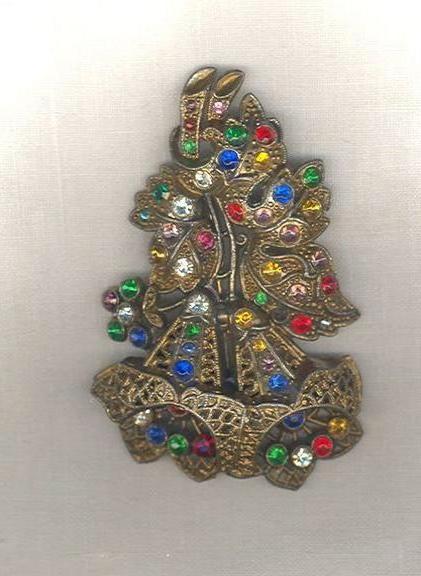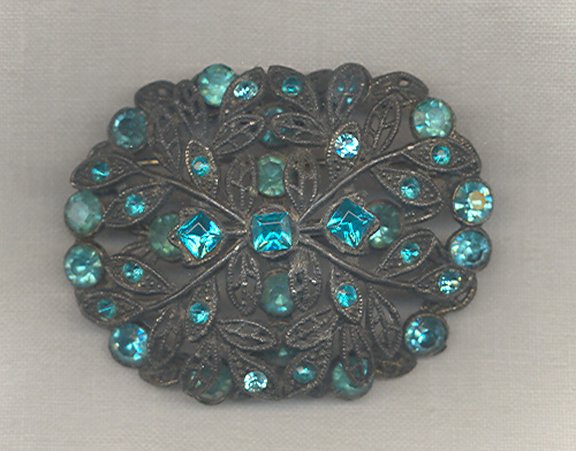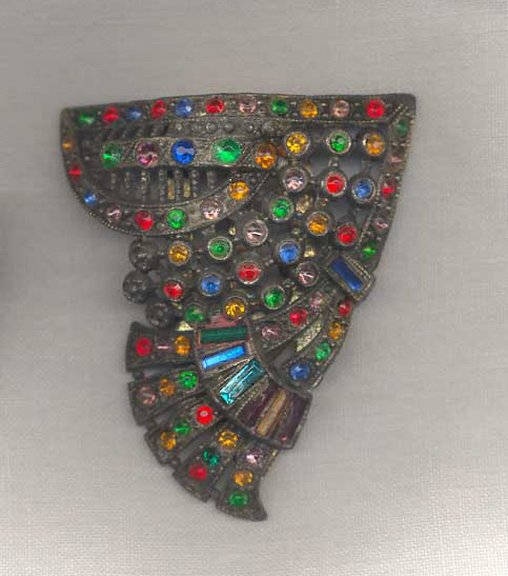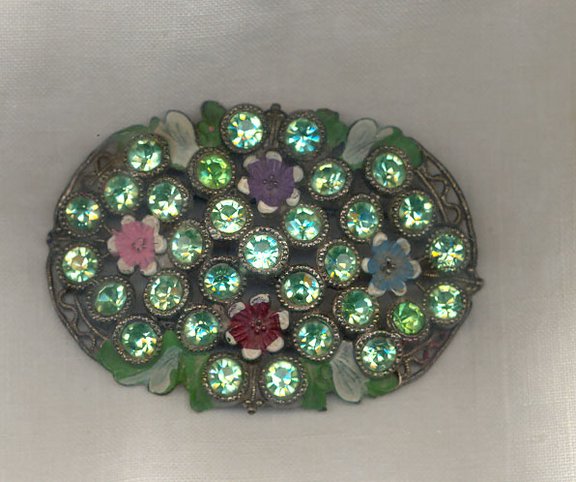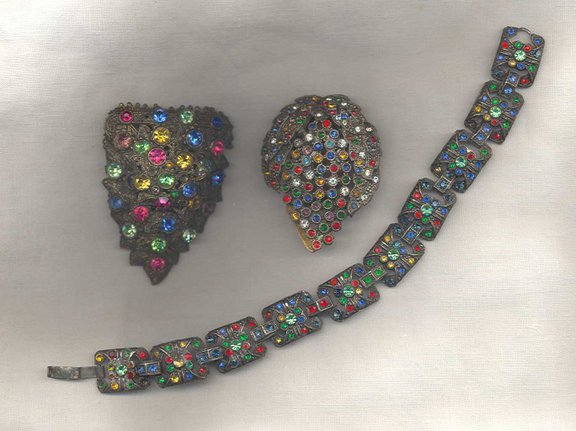Welcome to the Vintage Costume Jewelry Workshop. We will be discussing 20th costume jewelry - mostly American, concentrating on the 1920’s-mid-1960’s. I have chosen to stop there, because my knowledge, interest and personal collection of vintage costume jewelry ends in the early 1960's.
Vintage costume jewelry is a very large topic. We will not be able to cover every aspect of it in this workshop. Almost every part of this presentation could be expanded into a full workshop. The jewelry photos in this workshop are either examples from my personal collection or pieces that I have sold with a few exceptions that are noted. I hope you will enjoy the workshop and feel free to ask questions.
I began collecting Vintage Costume Jewelry many years ago. When I was growing up I wore very traditional "fine" jewelry. I've always loved jewelry and when I began buying VCJ, I was first attracted to sparkly colored rhinestone jewelry. Later, when I really got “hooked” I discovered signed designer pieces from what many collectors consider the “Golden Age” of costume jewelry. (1935-1950). Later I became interested in earlier mostly unsigned Deco pieces -and then Bakelite but that's another story! The majority of my personal collection contains pieces from C. '20's - C.60's with a concentration on pieces from the 1930's and 1940's. Like many dealers, my collection “grew” – my preferences changed, and I began to sell. Now when I purchase pieces they are either “for me” or for my RL shop!
What makes a piece of jewelry "costume?" The basic difference between fine and costume jewelry is the materials they are made from. In addition costume jewelry was designed as a seasonal line meant to go with the "costumes or fashions of the day." There's a strong correlation between fashion and the jewelry that is/was worn with it.
Fine jewelry is made from precious metals – gold, platinum, etc. set with precious or semi-precious stones. Costume jewelry - for the most part - is made from plated base metals set with non-precious stones - rhinestones, plastic stones, glass stones, beads, etc., or is entirely base metal like pot metal or made from plastic, wood, aluminum, brass or a combination of materials. The exception is jewelry made from Sterling silver which falls into the costume camp - and is often set with "real" stones, usually semi-precious. We will not be discussing Mexican, Scandinavian or Native American Jewelry in this workshop. There are several people on the VFG forums who know much more than I do about these areas of vintage jewelry and I hope they will offer their expertise in another workshop.
A very small amount of "costume" is set with semi-precious stones and natural material like coral, cultured pearls, or jade and turquoise, but is still made of plated base metal. Costume jewelry is plated with a very thin layer of gold, silver, copper or rhodium or a combination of these metals. The plating can and does wear off in time. When you are describing the finish, it is referred to as “goldtone” –“silvertone”, rhodium plated, etc. The vast majority of costume jewelry is set with rhinestones, which are usually Austrian crystals, made by Swarovski, or with “faux” or simulated pearls, moonstones – or other glass stones some meant to mimic “real” gem stones. Some of the stones came from Bohemia. We will be discussing jewelry that was available in department or specialty stores, made and sold by companies like Trifari, Coro, Boucher, Mazer Bros., Miriam Haskell, Napier, etc. - or made by manufacturers like DeLizza and Elster (D&E) and others who showed their lines and/or "jobbed" to companies like Weiss, Kramer, etc.
As I mentioned the jewelry was part of a semi-annual seasonal line. No one expected that 50-90 years later that collectors and dealers would be wondering where and when it was made – and sometimes what it is!
Jewelry generally follows the same periods that fashion follows with an important exception noted below. We label pieces as Victorian, Edwardian, Deco, Retro – or ‘20’s-30’s, etc. We use circa dating in jewelry - C. indicating a ten year spread on either side of a date. It’s very important to remember when trying to date jewelry that (unlike fashion – where to quote Heidi “one day you are in and the next day you are out”) - frequently good selling popular items remained in the line for years. Jewelry styles - unlike fashion changed slowly. Sometime it can be difficult to date a piece accurately, while at other times world or current events brought about change rapidly by creating a new look to compliment the latest fashions OR stopped the production of a type of jewelry when the raw materials became unavailable. To further complicate matters many styles were revived more than once, so it's important to look at all the elements in a piece when trying to date it.
Most early vintage costume jewelry is not “signed” or marked with a maker’s mark but a small amount is. If you find a piece with a signature, the very best online resource to find out about it is Researching Costume Jewelry: http://www.illusionjewels.com/costumejewelrymarks.html
Another wonderful resource for all sorts of information about dating and a great treasury of vintage jewelry ads is: http://www.morninggloryantiques.com/JewelChat.htm
Both sites contain wonderful information about vintage jewelry.
Before we start on the specific periods I want to mention that “costume” or non-precious jewelry is not a 19th or 20th C. concept. Ancient civilizations had non-precious jewelry and it appears throughout all times. For the most part, non-precious jewelry mimicked pieces that were first made in precious metals. Here’s an example of a 19C. antique diamond flower brooch mounted in silver topped gold C. 1870 that was on Fred Leighton’s site some time ago:
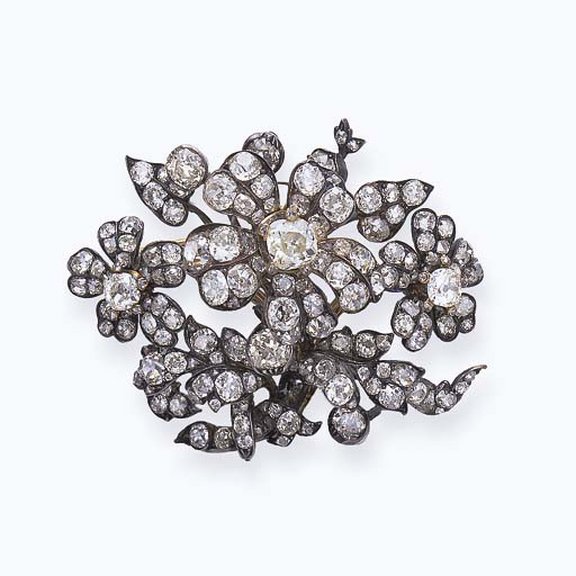
and a 19C. paste pin from Carole Tannebaum’s “Fabulous Fakes.” This piece is mounted in brass and is 4” long.
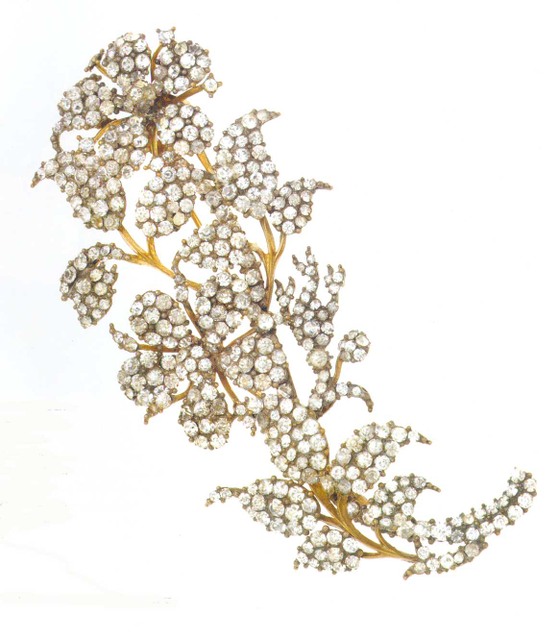
This piece is not "costume." The metal used is gold. It is Victorian, C. 1880, and has an old "tube" hinge and a "C" clasp. The tube hinge was used until about 1890, and the long pin stem and "C" clasp are indicative of Victorian jewelry both fine and costume:
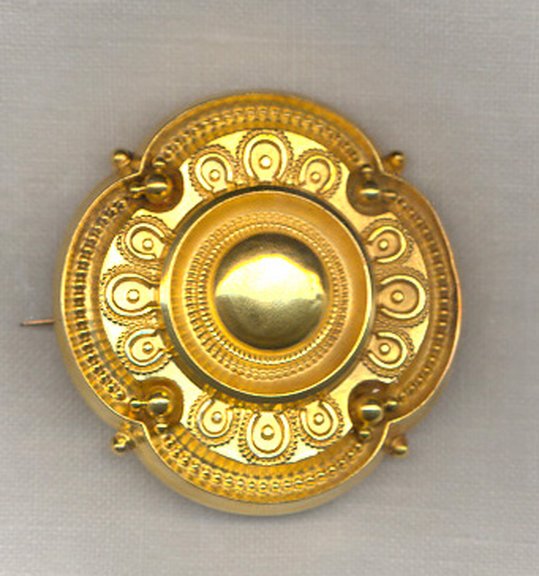

Here’s a slightly later paste piece from my collection. It's set in brass and is a collar pin:
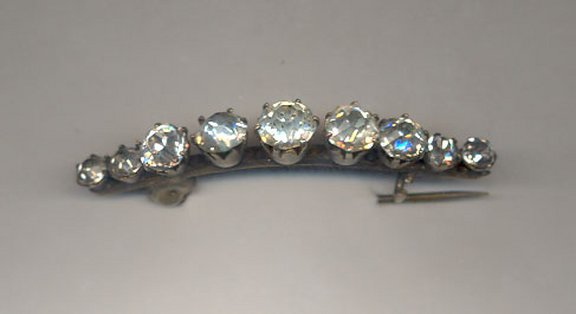

Here are some examples of “paste” jewelry – most are C.1920’s and 1930’s, and they all "mimic" fine jewelry of the period.
First a KTF dress clip:
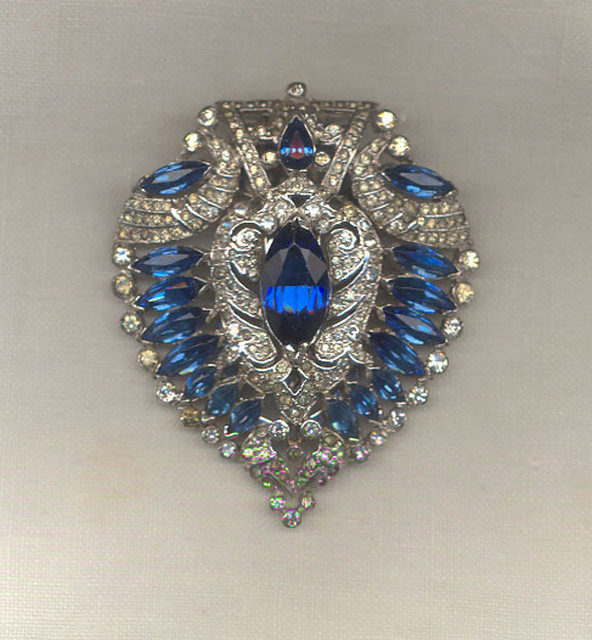
An early ‘30’s unsigned brooch:
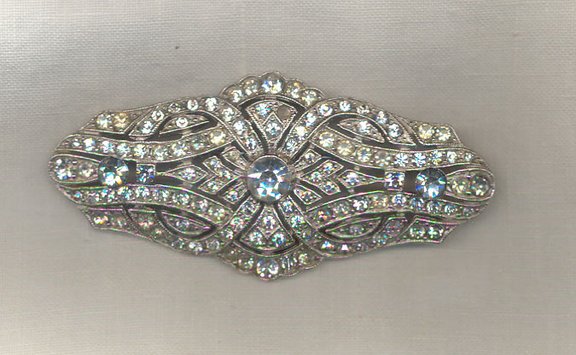
A C. 1920’s - or possibly late teens pin made by George H. Cahoone & Co. of Providence, R.I. (1886 until 1931)

When you find a piece of jewelry how can you tell how old it is?
Here are some things to consider:
• Style
• Metal(s) Used
• Construction
• Stones – Cut, Color and How Set
• Findings Used – pin stem, hinges, earring backs, etc.
• Patent Number - if there is one
• Copyright Symbol ©
• Vintage Ads, Books, Movies, Etc
First Style: Do you recognize the style as belonging to a particular period or limited to that period? Would it have a special use or be appropriate for certain fashions of the day? Are the stones a color that was really popular or significant in that era?
The "sapphire" dress clip shown above was made between 1935 and 1937. We can narrow it down that closely because it’s signed KTF (Krussman, Trifari and Fishel) - and beginning in 1937, their pieces were marked Trifari. The style is “Deco” and it’s a “dress clip.”
Dress clips were the most important jewelry accessory of the 1930’s. They were used, frequently in pairs, from the late ‘20’s until the ‘50’s; but not as often after the ‘30’s. We’ll talk more about dress clips when we talk about the 1930's.
During WWII many pieces of jewelry were red white and blue, pieces were made in the shape of airplanes, "V's" for Victory or even sailors in uniform! The wings and the P38 airplane earrings are "sweetheart" jewelry, and would have been worn by the wife or sweetheart of the pilot. The stones are plastic - rhinestones were in short supply during the War.
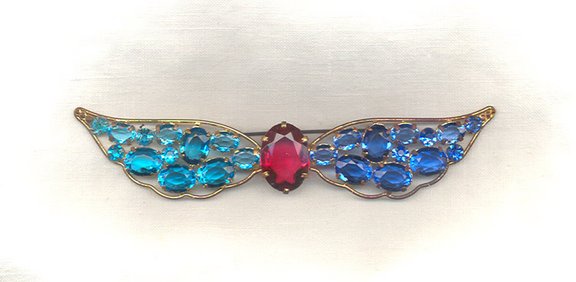
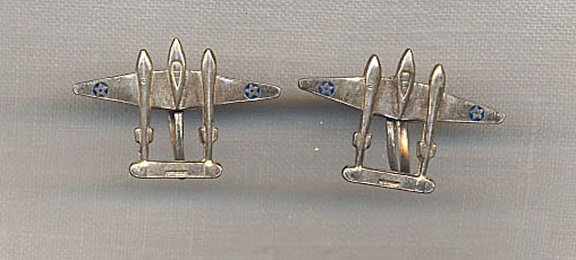
Second: Metal
What is the type of metal used and is it plated? The KTF dress clip is rhodium plated. Rhodium plating was not used until the '30's. The Cahoone brooch is sterling silver with “paste” stones.
Here’s a late ‘20’s – early ‘30’s potmetal piece signed L/N which stands for Little Nemo.
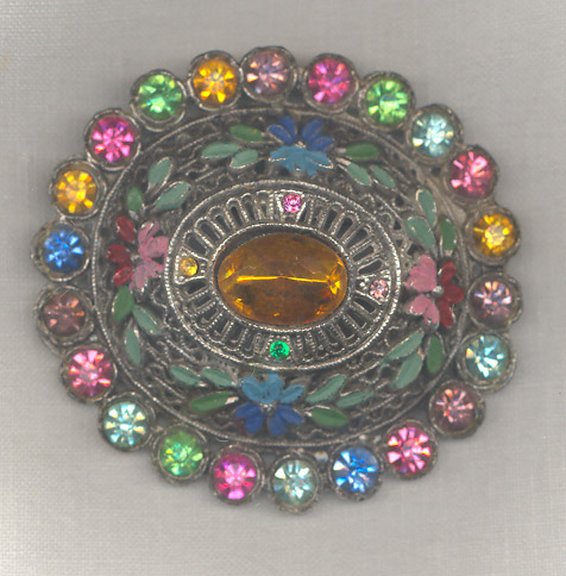
Here’s a view of the back:
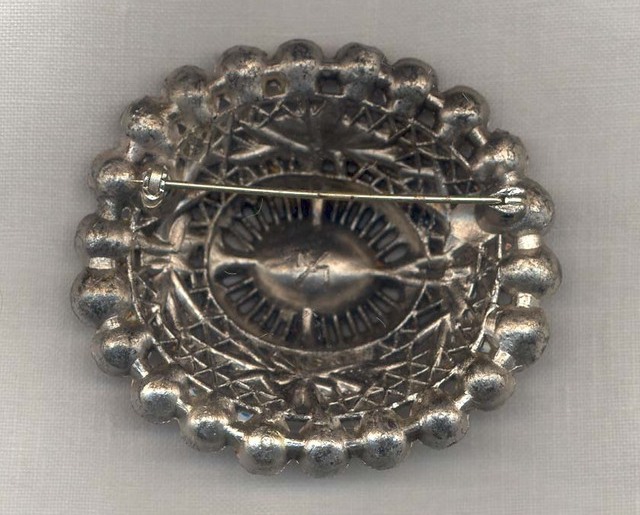
We know this is late '20's early '30's because of the style - and because it is made of potmetal. Potmetal is white metal – from various sources that has been “mixed and melted in a pot” – hence the name. Some of it might be tin, some zinc, etc.
One very, very important thing that I should have mentioned earlier is ALWAYS look at the back of the pieces after you look at the front. The back tells a lot of the story.
Let's talk about the early paste collar pin set in brass shown above. First - the stones are not modern cut rhinestones. They are set with “prongs” in a setting that looks sort of like a crown – but is different from a modern “crown” setting. The metal looks (and smells) like brass and the back of the pin shows an old style “C” clasp – and an early riveted hinge which was first used in the 1890's after the tube hinge. The pin stem projects past the catch, which is a characteristic of older pieces.
Here's another KTF piece. It is rhodium plated and has a much later hinge and a modern safety clasp.
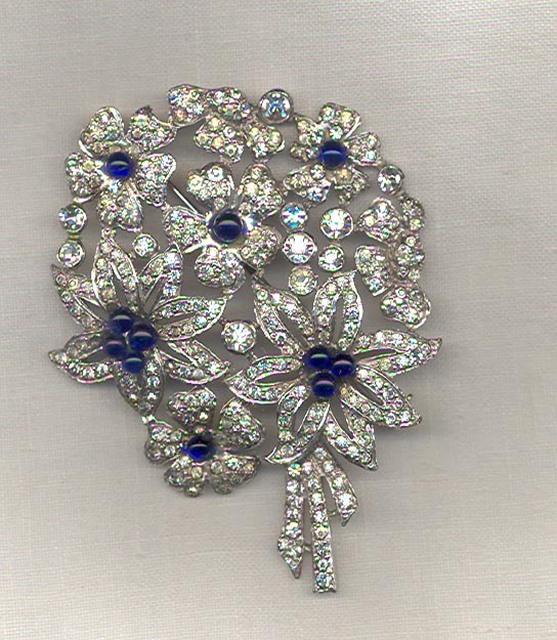
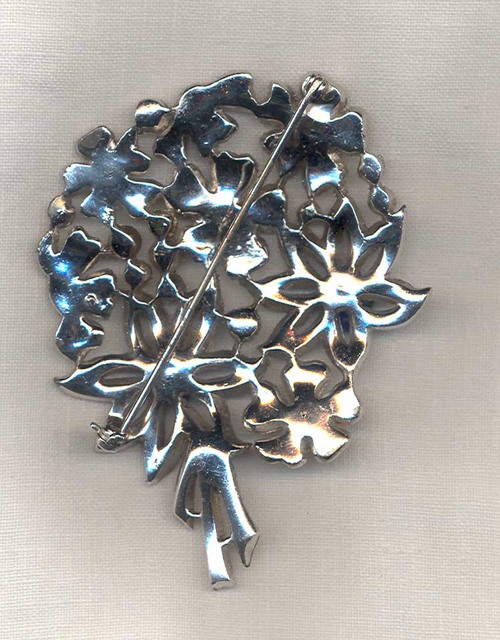
Early safety catches look a lot like "safety pins" - the modern safety catch dates to the 1920's.
I've skipped around a little from the order on list above, but I've mentioned some important findings that help tell us how old a piece might be. It's important to remember that knowing when the findings (the components that hold the piece together or make it open and close) were first used tells us that a piece is not "older" than a certain date - but some older findings like the "C" clasp are still used today. If you learn when certain findings or components were first used or were especially in vogue, it's easier to date pieces. The term “findings” also refers to parts of jewelry like the stamped metal leaves or glass flowers, etc. Findings were made in Providence and also imported from Bohemia.
The construction tells us quite a bit which is why it is so important to look at the back. Most older - pre-late 1950's good quality jewelry was made in a mold and was hand polished. The stones were hand-set. The rhodium plated brooch shown above is a good example of a late 1930's piece.
Here are two unsigned 1940's brooches. The first one is made in sections and screwed together. The second one was made in one piece. Another very interesting thing about these pieces is that the stones on the aqua brooch are not foiled. Stones were and are generally foiled to make them more reflective. The foil is the gold or silver that you can see from the back if the setting is open. (Part of the brooch with the "sapphire" colored stones has an open back and you can see the foil.)
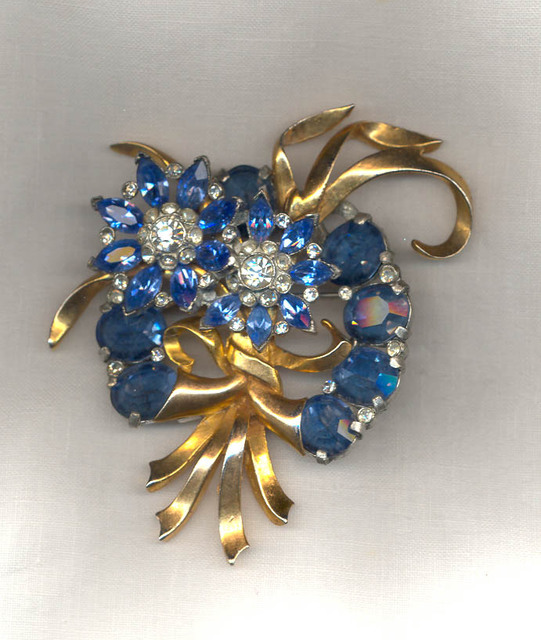
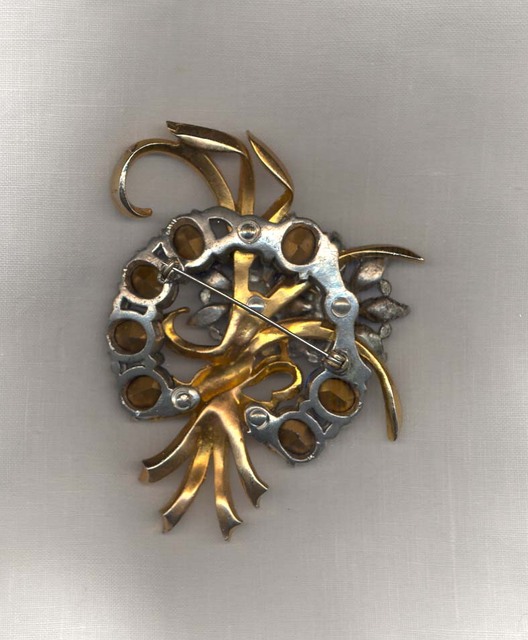
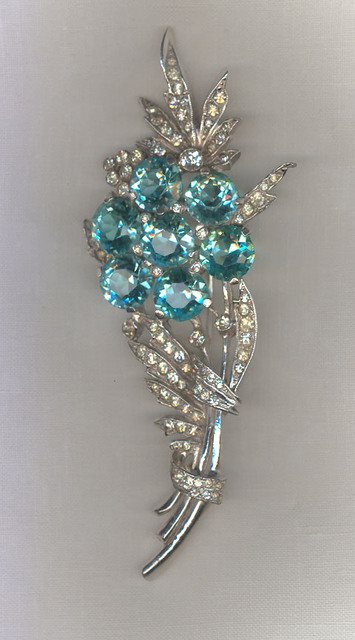
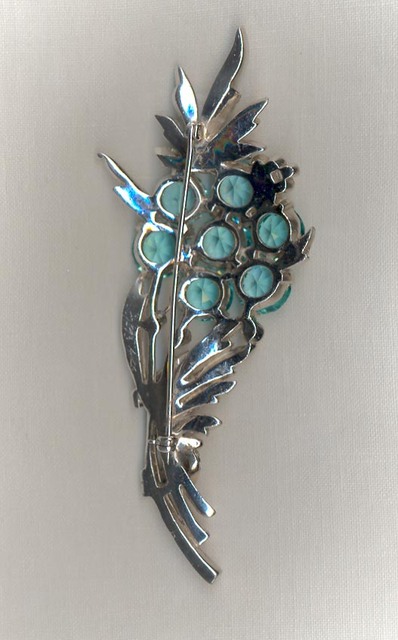
I mentioned "paste" stones earlier. Modern rhinestones have "modern cuts." Some earlier stones in addition to having unusual and no longer available shapes often have very high "tables" and look like old mine cut diamonds.
Most older pieces have stones that were hand set either in prong settings or bead settings although there are some pieces that are glued. Most pieces from the late '50's on have faux prong settings and are glued. This in not "set in stone" or "goldtone plating" but it's a good rule of thumb. If the piece you are looking at has aurora borealis stones, you'll know that it is not earlier than the mid-'50's. Aurora borealis or "AB" stones have a vacuum coating which reflects the light in a way that appears to make the colors change. Here's an example - the AB stones are at the top; the dangling stones are not coated:
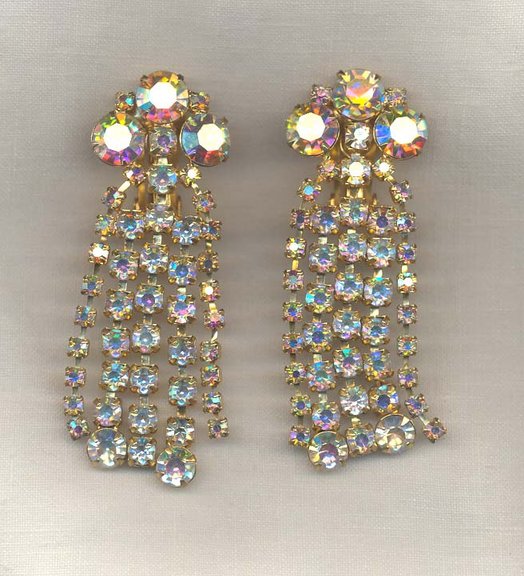
By the very late 1950's, pieces were made in rubber molds and spun-cast - the backs were no longer finished by hand and were textured, not smooth. Here's an example of a late '50's brooch signed Monet:
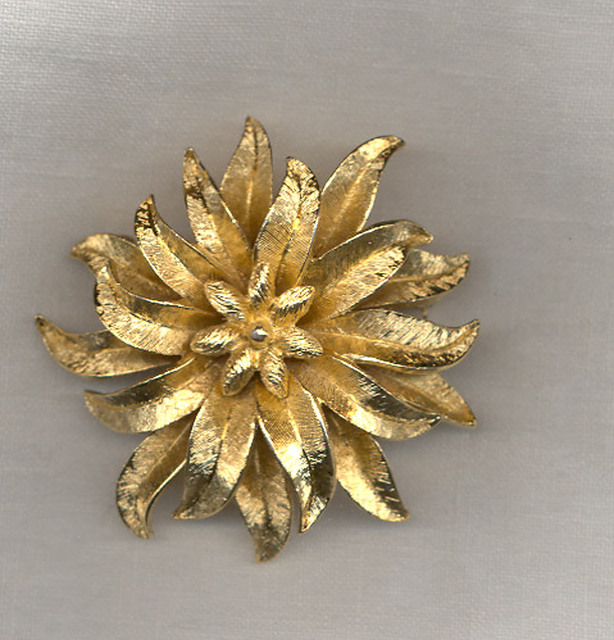
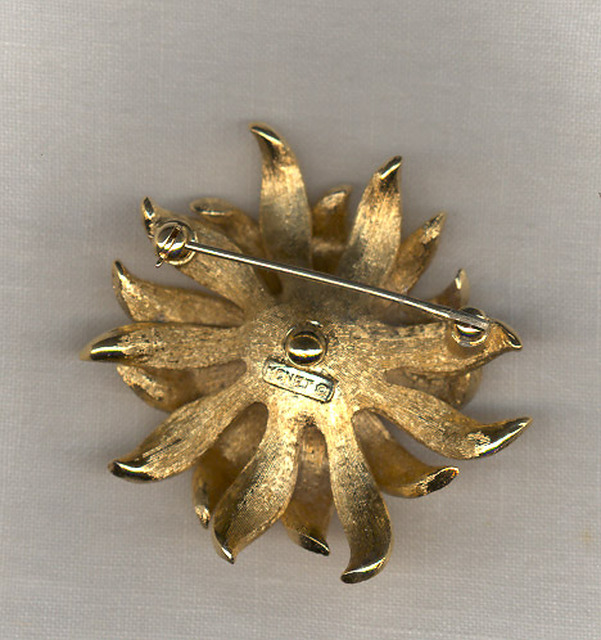
Some pieces were made in sections and then put together. That technique is called "manipulation." Here is one of my favorite pieces. I think it's somewhat whimsical. It is made in sections - of aluminum and plastic and is assembled or manipulated. You can see from the back view that the side pieces were pre-stamped and then it was wired together. This piece is C. 1930's. Not expensive then or now but so fun!
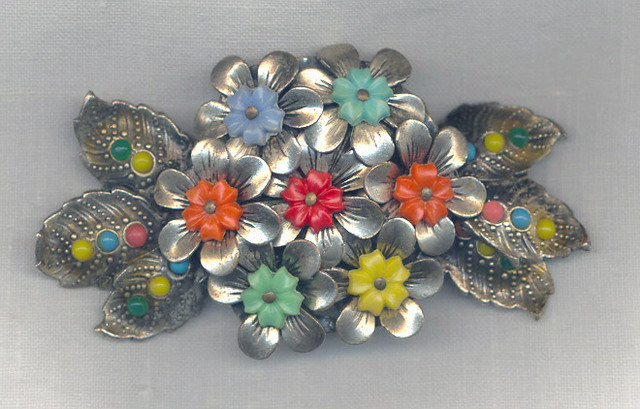
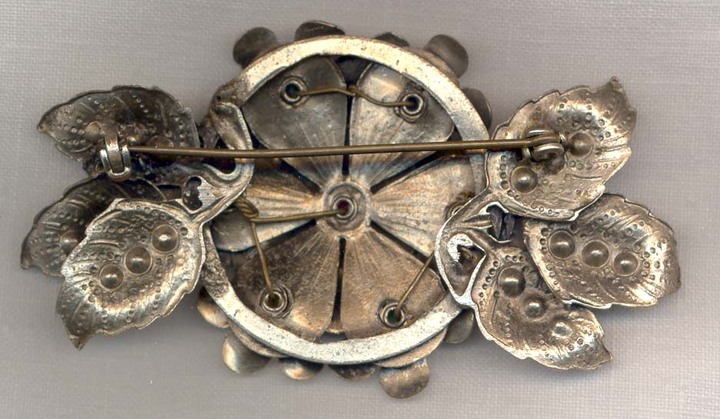
Most Miriam Haskell jewelry was manipulated or assembled. Another construction method is called "swedged." The jewelry is made from components and soldered together. D&E aka Juliana jewelry is made this way. Here is an example:
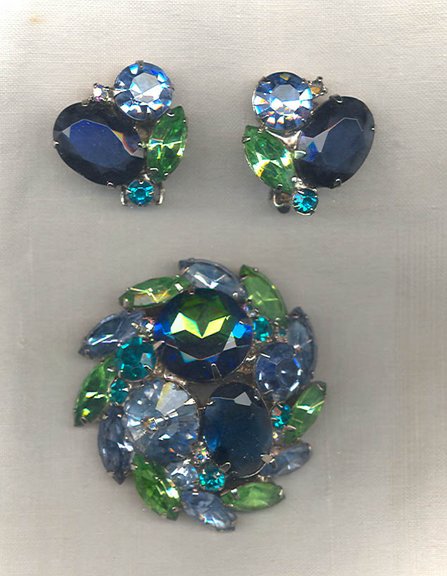
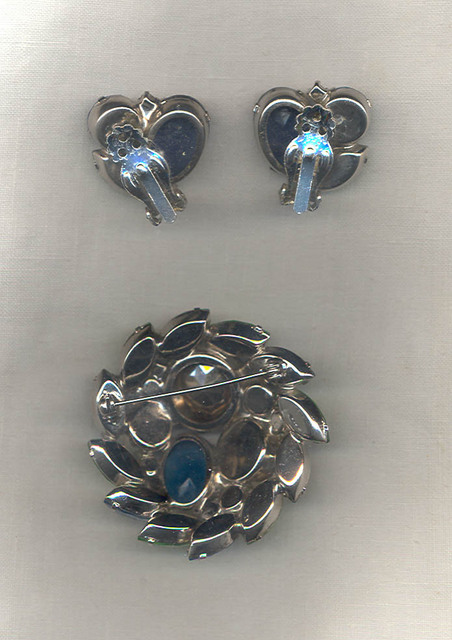
Some pieces like the 1940's brooch with the sapphire colored stones we looked at earlier is a combination of technique. Most of the piece was made in a mold or molds, but it was screwed together.
Some pieces from the late '30's to the mid-'50's have patent numbers or are marked Pat. Pend. The designs were patented by the companies or the artists who drew the design. Most of the pieces that are marked Pat. Pending were produced prior to the approval of the patent. If you find a piece with a patent number, you can visit the US Patent site and view the patent. I've put this "piece" with the patent:
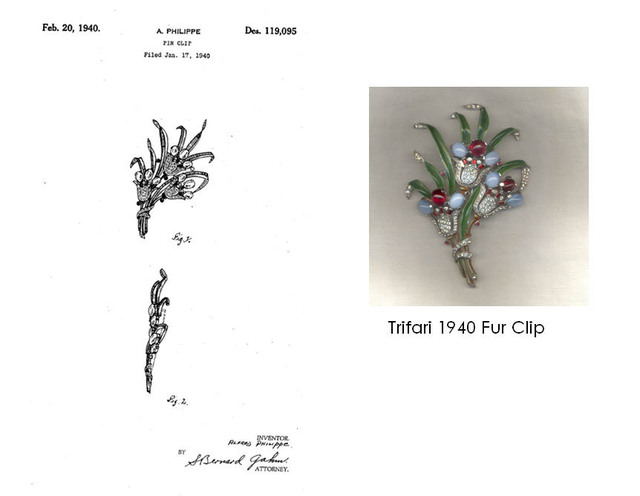
Sometimes you will find earrings, a bracelet, or a double clip brooch (called a Duette by Coro) with a patent number on it. This patent is a "utility" patent and is for the clip or the mechanism. It can only tell you the earliest that piece was made since in the case of earrings the clip might still be in use today.
Many pieces from the mid-'50's on are marked with a copyright symbol - © like the gold tone Florentine finished brooch above. There was a famous lawsuit which Trifari won in 1955 that pretty much ended the patenting of jewelry designs. After that most manufacturers put the © symbol on their pieces - but not all - so you have to look at all the elements to determine when your piece was made. Most of the time if you find a © symbol on your piece it was made after 1955.
If you can find the patent you can be pretty sure of the date and if you can find an ad for the piece or a similar piece then you can really narrow it down. One of the sites I mentioned above - has lots of jewelry ads like this 1938 Trifari Ad:
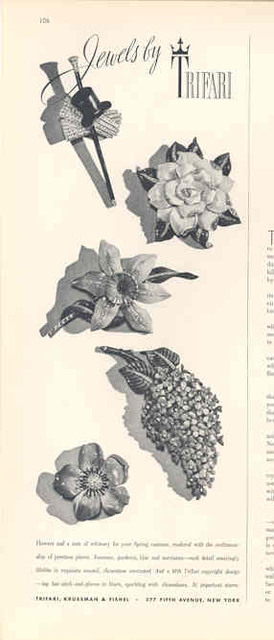
More in Part II.
Vintage costume jewelry is a very large topic. We will not be able to cover every aspect of it in this workshop. Almost every part of this presentation could be expanded into a full workshop. The jewelry photos in this workshop are either examples from my personal collection or pieces that I have sold with a few exceptions that are noted. I hope you will enjoy the workshop and feel free to ask questions.
I began collecting Vintage Costume Jewelry many years ago. When I was growing up I wore very traditional "fine" jewelry. I've always loved jewelry and when I began buying VCJ, I was first attracted to sparkly colored rhinestone jewelry. Later, when I really got “hooked” I discovered signed designer pieces from what many collectors consider the “Golden Age” of costume jewelry. (1935-1950). Later I became interested in earlier mostly unsigned Deco pieces -and then Bakelite but that's another story! The majority of my personal collection contains pieces from C. '20's - C.60's with a concentration on pieces from the 1930's and 1940's. Like many dealers, my collection “grew” – my preferences changed, and I began to sell. Now when I purchase pieces they are either “for me” or for my RL shop!
What makes a piece of jewelry "costume?" The basic difference between fine and costume jewelry is the materials they are made from. In addition costume jewelry was designed as a seasonal line meant to go with the "costumes or fashions of the day." There's a strong correlation between fashion and the jewelry that is/was worn with it.
Fine jewelry is made from precious metals – gold, platinum, etc. set with precious or semi-precious stones. Costume jewelry - for the most part - is made from plated base metals set with non-precious stones - rhinestones, plastic stones, glass stones, beads, etc., or is entirely base metal like pot metal or made from plastic, wood, aluminum, brass or a combination of materials. The exception is jewelry made from Sterling silver which falls into the costume camp - and is often set with "real" stones, usually semi-precious. We will not be discussing Mexican, Scandinavian or Native American Jewelry in this workshop. There are several people on the VFG forums who know much more than I do about these areas of vintage jewelry and I hope they will offer their expertise in another workshop.
A very small amount of "costume" is set with semi-precious stones and natural material like coral, cultured pearls, or jade and turquoise, but is still made of plated base metal. Costume jewelry is plated with a very thin layer of gold, silver, copper or rhodium or a combination of these metals. The plating can and does wear off in time. When you are describing the finish, it is referred to as “goldtone” –“silvertone”, rhodium plated, etc. The vast majority of costume jewelry is set with rhinestones, which are usually Austrian crystals, made by Swarovski, or with “faux” or simulated pearls, moonstones – or other glass stones some meant to mimic “real” gem stones. Some of the stones came from Bohemia. We will be discussing jewelry that was available in department or specialty stores, made and sold by companies like Trifari, Coro, Boucher, Mazer Bros., Miriam Haskell, Napier, etc. - or made by manufacturers like DeLizza and Elster (D&E) and others who showed their lines and/or "jobbed" to companies like Weiss, Kramer, etc.
As I mentioned the jewelry was part of a semi-annual seasonal line. No one expected that 50-90 years later that collectors and dealers would be wondering where and when it was made – and sometimes what it is!
Jewelry generally follows the same periods that fashion follows with an important exception noted below. We label pieces as Victorian, Edwardian, Deco, Retro – or ‘20’s-30’s, etc. We use circa dating in jewelry - C. indicating a ten year spread on either side of a date. It’s very important to remember when trying to date jewelry that (unlike fashion – where to quote Heidi “one day you are in and the next day you are out”) - frequently good selling popular items remained in the line for years. Jewelry styles - unlike fashion changed slowly. Sometime it can be difficult to date a piece accurately, while at other times world or current events brought about change rapidly by creating a new look to compliment the latest fashions OR stopped the production of a type of jewelry when the raw materials became unavailable. To further complicate matters many styles were revived more than once, so it's important to look at all the elements in a piece when trying to date it.
Most early vintage costume jewelry is not “signed” or marked with a maker’s mark but a small amount is. If you find a piece with a signature, the very best online resource to find out about it is Researching Costume Jewelry: http://www.illusionjewels.com/costumejewelrymarks.html
Another wonderful resource for all sorts of information about dating and a great treasury of vintage jewelry ads is: http://www.morninggloryantiques.com/JewelChat.htm
Both sites contain wonderful information about vintage jewelry.
Before we start on the specific periods I want to mention that “costume” or non-precious jewelry is not a 19th or 20th C. concept. Ancient civilizations had non-precious jewelry and it appears throughout all times. For the most part, non-precious jewelry mimicked pieces that were first made in precious metals. Here’s an example of a 19C. antique diamond flower brooch mounted in silver topped gold C. 1870 that was on Fred Leighton’s site some time ago:

and a 19C. paste pin from Carole Tannebaum’s “Fabulous Fakes.” This piece is mounted in brass and is 4” long.

This piece is not "costume." The metal used is gold. It is Victorian, C. 1880, and has an old "tube" hinge and a "C" clasp. The tube hinge was used until about 1890, and the long pin stem and "C" clasp are indicative of Victorian jewelry both fine and costume:


Here’s a slightly later paste piece from my collection. It's set in brass and is a collar pin:


Here are some examples of “paste” jewelry – most are C.1920’s and 1930’s, and they all "mimic" fine jewelry of the period.
First a KTF dress clip:

An early ‘30’s unsigned brooch:

A C. 1920’s - or possibly late teens pin made by George H. Cahoone & Co. of Providence, R.I. (1886 until 1931)

When you find a piece of jewelry how can you tell how old it is?
Here are some things to consider:
• Style
• Metal(s) Used
• Construction
• Stones – Cut, Color and How Set
• Findings Used – pin stem, hinges, earring backs, etc.
• Patent Number - if there is one
• Copyright Symbol ©
• Vintage Ads, Books, Movies, Etc
First Style: Do you recognize the style as belonging to a particular period or limited to that period? Would it have a special use or be appropriate for certain fashions of the day? Are the stones a color that was really popular or significant in that era?
The "sapphire" dress clip shown above was made between 1935 and 1937. We can narrow it down that closely because it’s signed KTF (Krussman, Trifari and Fishel) - and beginning in 1937, their pieces were marked Trifari. The style is “Deco” and it’s a “dress clip.”
Dress clips were the most important jewelry accessory of the 1930’s. They were used, frequently in pairs, from the late ‘20’s until the ‘50’s; but not as often after the ‘30’s. We’ll talk more about dress clips when we talk about the 1930's.
During WWII many pieces of jewelry were red white and blue, pieces were made in the shape of airplanes, "V's" for Victory or even sailors in uniform! The wings and the P38 airplane earrings are "sweetheart" jewelry, and would have been worn by the wife or sweetheart of the pilot. The stones are plastic - rhinestones were in short supply during the War.


Second: Metal
What is the type of metal used and is it plated? The KTF dress clip is rhodium plated. Rhodium plating was not used until the '30's. The Cahoone brooch is sterling silver with “paste” stones.
Here’s a late ‘20’s – early ‘30’s potmetal piece signed L/N which stands for Little Nemo.

Here’s a view of the back:

We know this is late '20's early '30's because of the style - and because it is made of potmetal. Potmetal is white metal – from various sources that has been “mixed and melted in a pot” – hence the name. Some of it might be tin, some zinc, etc.
One very, very important thing that I should have mentioned earlier is ALWAYS look at the back of the pieces after you look at the front. The back tells a lot of the story.
Let's talk about the early paste collar pin set in brass shown above. First - the stones are not modern cut rhinestones. They are set with “prongs” in a setting that looks sort of like a crown – but is different from a modern “crown” setting. The metal looks (and smells) like brass and the back of the pin shows an old style “C” clasp – and an early riveted hinge which was first used in the 1890's after the tube hinge. The pin stem projects past the catch, which is a characteristic of older pieces.
Here's another KTF piece. It is rhodium plated and has a much later hinge and a modern safety clasp.


Early safety catches look a lot like "safety pins" - the modern safety catch dates to the 1920's.
I've skipped around a little from the order on list above, but I've mentioned some important findings that help tell us how old a piece might be. It's important to remember that knowing when the findings (the components that hold the piece together or make it open and close) were first used tells us that a piece is not "older" than a certain date - but some older findings like the "C" clasp are still used today. If you learn when certain findings or components were first used or were especially in vogue, it's easier to date pieces. The term “findings” also refers to parts of jewelry like the stamped metal leaves or glass flowers, etc. Findings were made in Providence and also imported from Bohemia.
The construction tells us quite a bit which is why it is so important to look at the back. Most older - pre-late 1950's good quality jewelry was made in a mold and was hand polished. The stones were hand-set. The rhodium plated brooch shown above is a good example of a late 1930's piece.
Here are two unsigned 1940's brooches. The first one is made in sections and screwed together. The second one was made in one piece. Another very interesting thing about these pieces is that the stones on the aqua brooch are not foiled. Stones were and are generally foiled to make them more reflective. The foil is the gold or silver that you can see from the back if the setting is open. (Part of the brooch with the "sapphire" colored stones has an open back and you can see the foil.)




I mentioned "paste" stones earlier. Modern rhinestones have "modern cuts." Some earlier stones in addition to having unusual and no longer available shapes often have very high "tables" and look like old mine cut diamonds.
Most older pieces have stones that were hand set either in prong settings or bead settings although there are some pieces that are glued. Most pieces from the late '50's on have faux prong settings and are glued. This in not "set in stone" or "goldtone plating" but it's a good rule of thumb. If the piece you are looking at has aurora borealis stones, you'll know that it is not earlier than the mid-'50's. Aurora borealis or "AB" stones have a vacuum coating which reflects the light in a way that appears to make the colors change. Here's an example - the AB stones are at the top; the dangling stones are not coated:

By the very late 1950's, pieces were made in rubber molds and spun-cast - the backs were no longer finished by hand and were textured, not smooth. Here's an example of a late '50's brooch signed Monet:


Some pieces were made in sections and then put together. That technique is called "manipulation." Here is one of my favorite pieces. I think it's somewhat whimsical. It is made in sections - of aluminum and plastic and is assembled or manipulated. You can see from the back view that the side pieces were pre-stamped and then it was wired together. This piece is C. 1930's. Not expensive then or now but so fun!


Most Miriam Haskell jewelry was manipulated or assembled. Another construction method is called "swedged." The jewelry is made from components and soldered together. D&E aka Juliana jewelry is made this way. Here is an example:


Some pieces like the 1940's brooch with the sapphire colored stones we looked at earlier is a combination of technique. Most of the piece was made in a mold or molds, but it was screwed together.
Some pieces from the late '30's to the mid-'50's have patent numbers or are marked Pat. Pend. The designs were patented by the companies or the artists who drew the design. Most of the pieces that are marked Pat. Pending were produced prior to the approval of the patent. If you find a piece with a patent number, you can visit the US Patent site and view the patent. I've put this "piece" with the patent:

Sometimes you will find earrings, a bracelet, or a double clip brooch (called a Duette by Coro) with a patent number on it. This patent is a "utility" patent and is for the clip or the mechanism. It can only tell you the earliest that piece was made since in the case of earrings the clip might still be in use today.
Many pieces from the mid-'50's on are marked with a copyright symbol - © like the gold tone Florentine finished brooch above. There was a famous lawsuit which Trifari won in 1955 that pretty much ended the patenting of jewelry designs. After that most manufacturers put the © symbol on their pieces - but not all - so you have to look at all the elements to determine when your piece was made. Most of the time if you find a © symbol on your piece it was made after 1955.
If you can find the patent you can be pretty sure of the date and if you can find an ad for the piece or a similar piece then you can really narrow it down. One of the sites I mentioned above - has lots of jewelry ads like this 1938 Trifari Ad:

More in Part II.




